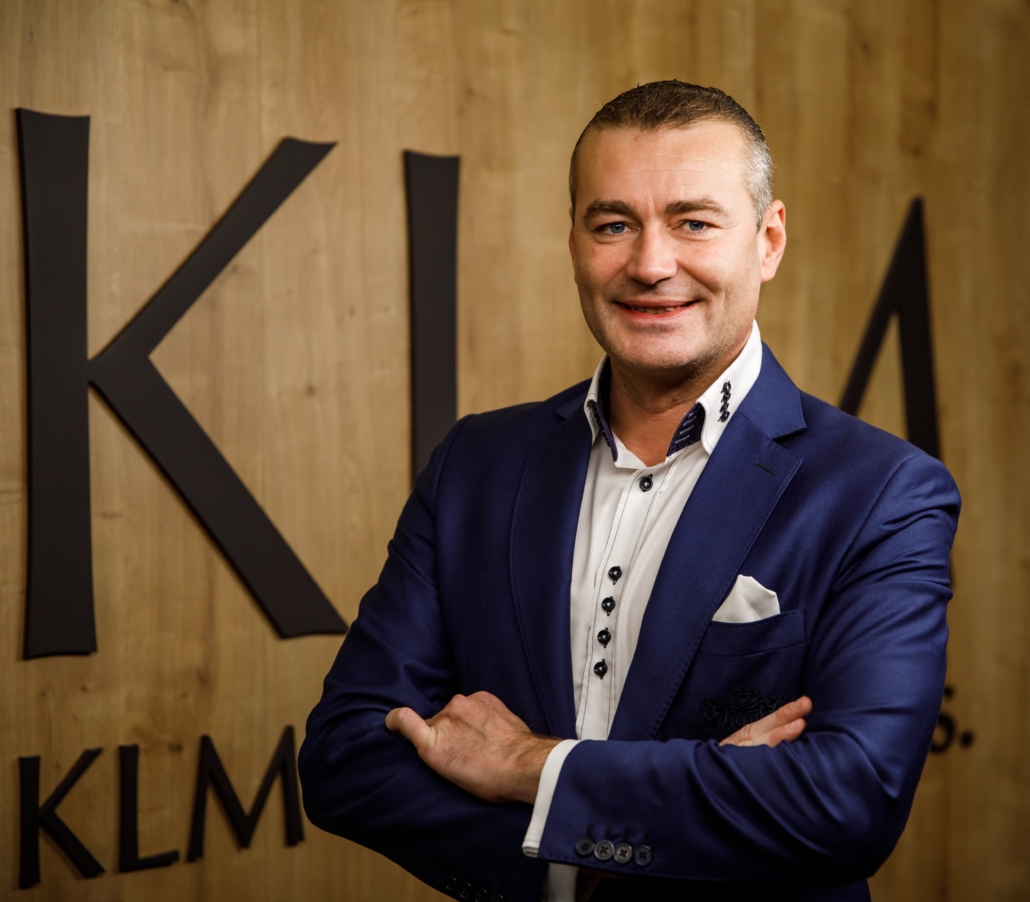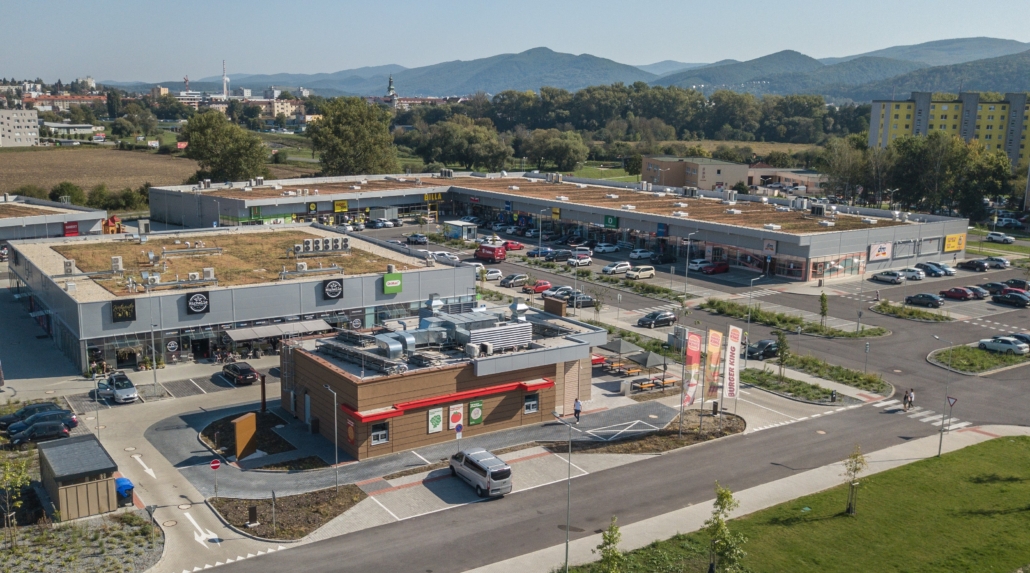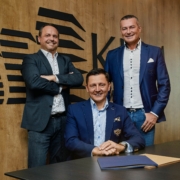The KLM development company is building retail in the Czech Republic
Almost 20 years ago, three entrepreneurs – Rastislav Čačko, Vladimír Buček and Michal Kozáček – merged their companies and founded the KLM development company. Its name has nothing to do with the airline but represents the initials of their wives‘ first names.
At first, they focused on the development of apartments and logistics and business premises, but gradually they started specializing in the development of retail centres, to which they currently pay most attention. Two of the partners, Ing. Rastislav Čačko a Ing. Vladimír Buček, informed us about KLM’s activities.
 Which centre was the first one?
Which centre was the first one?
RČ: The first retail park was built in Zvolen in 2012. I come from there, so, we naturally had very good relations there. We managed to buy quite a lot of land there and gradually built the entire retail park, which today occupies an area of about 40 hectares. It has become the most significant retail centre in central Slovakia. Today, there are Metro, Merkury Market, OBI, several stores such as Lidl, Tesco, McDonald’s, KFC, Burger King and also our OC Klokan, which is quite successful and in which we applied many green elements that we started using in shopping centres and will continue to do so.
What is your vision for the Czech real estate market?
RČ: In Slovakia, we have opened 27 shopping centres worth about 3.5 billion CZK in approximately 10 years, and we have been preparing to enter the Czech Republic for about two years. We bought several projects in various stages of development, mostly with planning permission. We are completing the process of obtaining building permits and gradually starting the construction of particular shopping centres. Preparation was very complicated because the prices of construction work increased significantly two years ago. Therefore, in addition to obtaining a building permit, our decision when to start construction was also influenced by high costs, even though the rent was already agreed in advance and its amount did not reflect reality. So we adjusted the projects that did not fully meet the parameters of our standards, and at the same time, we also adjusted contracts with our future tenants. After all, the contractual conditions and the form of the rental agreement in Slovakia differ from those in the Czech Republic. Today, we have a comprehensive team in the Czech Republic and we have our own CEO who leads it. We managed to successfully open the first project in Humpolec and the second one in Lipník nad Bečvou. We are currently starting construction in Bystřice pod Hostýnem and in Úpice.
VB: It needs to be said that the impulse to expand into the Czech Republic came from tenants who were very satisfied with our work in Slovakia and wanted us in the Czech Republic as well. That was the reason for us to say: OK, let’s see how it works there. We managed to buy a few decent projects and continue looking further. We don’t want to stay with the six we have. We want about 20 of them. The plan is to have three or four projects a year. We are now in the phase of looking for other acquisitions.

Which projects will you implement in the near future?
RČ: We have more of them in progress; one of the, let’s say, closest one is in Uničov, where we are just before having the building permit issued. It will be a nice project, 7,000 sq m, and then we are preparing another one in Karlovy Vary. There are several other prospective offers on our table, which we are evaluating further.
What is the added value of Klokan projects?
RČ: It is the care of the environment, which – as we all feel – is undergoing significant changes. Retail parks, logistics centres and similar buildings cause overheating of the environment and draining of surface water from the site. On that account, we were also looking, in cooperation with civic associations, for some construction options that would mitigate these negative effects a little. The goal is for shopping centres to have less impact on the environment and to create a more pleasant environment in the city. So that retail does not only represent an economic model, but also a benefit for the community.
You have already seen it work in Slovakia…
RČ: We tried it in Zvolen, where we invested EUR 1.5 million in these green measures. We started with a green roof on a large area – 13,000 sq m. In its time, it was the largest green roof in the Czech Republic and Slovakia, and I think it works very well. We continued with green walls, drainage tiles, complex accumulation of water in a particular place, which is collected in storage tanks and then used for irrigation. In Zvolen, we planted a unique alley with more than 100 oaks and an educational trail in cooperation with the owner of the SuperZoo network, Dušan Plaček, and the local Technical University.
VB: Now, these ESG measures are a must and are required. We were a little ahead of our time. Three years ago, we started planning, and when Tatrabanka was financing this property for us, they said they needed bigger projects. And we are already doing all that. You don’t have to force us into it. Our Zvolen project was the first one that Tatrabanka financed under the ESG measures.

Let’s go back to the Czech Republic, where you come with your projects…
RČ: We entered the Czech Republic having experience from Slovakia, where we have already done a good number of projects and where we represent the largest developer of retail parks. Of course, everything started with surveys. We drove around Western Europe; we saw how it worked there and which model was successful. Both, in Slovakia and Czechia, there are suitable conditions for retail parks, because they do not work everywhere. But here, they do. There is a lot of interest from tenants, because they want to be closer to the customer. We used to start in cities of 20,000 people. The catchment area gradually decreased and now we are somewhere between 7,000 and 10,000 inhabitants per such a shopping centre. In the Czech Republic, it is a little less, although I must say that in the post-covid period, or in times of energy crisis, not all tenants want to go to places with 5,000 or 6,000 inhabitants and that they prefer larger centres. The first two projects have been successfully opened and I hope that this year we will open a centre in Úpice and in Bystřice pod Hostýnem. We will start building in Uničov, we will open it in a year, and the same goes for Karlovy Vary. The tenants are interested in long-term cooperation, they like the functioning green measures, they appreciate, for instance, the decrease in electricity consumption by an average of 30% compared to older projects. That was a very surprising number even for me.
Are you trying to adapt projects to the location? Is each of them somehow unique?
RČ: Entering each city is subjected to the basic rule that a certain group of tenants is interested. We mostly know their expansion plans, we know where they are going, where they are not located and where they would like to go. Then we choose the most suitable location in the city with respect to future traffic situation in a horizon of maybe 20 years, so that we don’t build something that would become separated in three years’ time by motorways and would not be interesting anymore. So, we evaluate the zoning plan and the possibilities of connecting to utility services. It is not always possible, so, in some projects, we also changed the zoning plan in order to be able to build. So far, we have always succeeded, even though it increases the duration of the project. Today, it is no longer the case that you open two years after purchasing the land. On average, it takes four to five years.
VB: Over the years, we have already standardized the projects, determined the minimum clear height required by the tenants. We make sure to save energy. Heating is needed, but on the other hand, the customer must feel comfortable there. So, it is all set to certain modules that we repeat, and they only differ in their positioning within the terrain like in Humpolec. The positioning in Karlovy Vary will be complicated just as it is in the unstable environment in Myjava; there, we place the construction more into the ground, but it almost always looks the same on the outside.
Why did you choose the name OC KLOKAN?
RČ: Three or four years ago, we wanted to create a certain name that was, as part of the construction of our shopping centres, close to people and that would identify us as KLM, so, we asked a marketing agency to find us a name. From several options, we chose the word ‘KLOKAN’ (kangaroo), which is comprehensible in both Slovak and Czech, evokes a pleasant feeling, is close to families, and also evokes what the retail park is used for, i.e. a relatively quick shopping. This implies the typical kangaroo sign – a hop, which makes the ‘hop in for shopping’ a beautiful slogan that goes with the name. In the less than two years that the ‘KLOKAN’ has been around, we already have eight shopping centres and this year, there will be 13 or 14. It is starting to take off nicely and we have very good feedback about the network itself and the redesign of the stores.
VB: The task was to make the name applicable in the Czech Republic as well, because at that time we knew that we wanted to expand there. At the same time, we wanted the name to be popular, to evoke positive emotions, and I think Klokan fulfils that.

You are talking about development. That means that you are constantly active in searching for suitable opportunities, right?
RČ: We are constantly looking for interesting plots of land in excellent locations with good transport accessibility in basically the whole of the Czech Republic. We are really looking for plots with an area of 1 ha at minimum, with the upper limit not limited, but we are more or less interested in plots up to 5 ha. We try to make the expansion regular. We have a certain goal of opening at least three or four projects a year. However, this does not limit us, so, if there are only two of them, nothing happens. We won’t do it at any cost, but the land has to be top notch so that tenants and customers are happy, shop there, and the shopping centre is profitable and successful.
So, when the opportunities are right, you really have no limits…
VB: So far, we register a great interest from partners to expand, expand branches, but there are also new brands coming. They see that the Czech market, even though it is much more saturated than in Slovakia, still represents a large area. In doing so, they de facto give us the impetus to search for new areas.
Arnošt Wagner
Photo: KLM Archive




Leave a Reply
Want to join the discussion?Feel free to contribute!